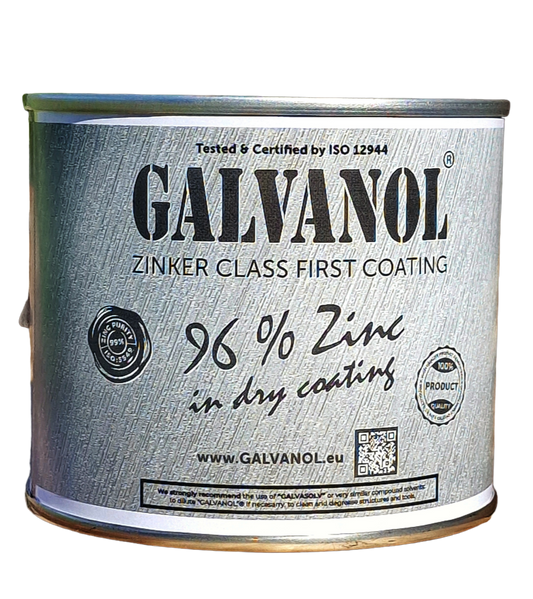The comparison between GALVANOL and hot dip galvanizing is based on their specific properties and advantages. Below are some points of comparison:
GALVANOL:
-
Composition:
- Contains 96% zinc in dry layer.
- Provides active cathodic protection.
-
Application:
- Widely used in a variety of industries and applications, mainly in structures and welding on ferrous iron, for surface repair of hot-dip galvanized.
- It constitutes an alternative and complement to hot-dip galvanizing, especially when welded joints and drilling in situ are required, or when the dimensions of the structure exceed the capacities of the crucible in the galvanizing plant .
- Formulated to adhere strongly to various surfaces.
-
Protection:
- Offers comprehensive protection in structures and welds.
- Active physical and cathodic protection that generates a protective current against corrosion. .
-
Durability:
- Ensures superior durability when the technical sheet is followed.
-
ISO regulations:
- Complies with ISO regulations such as: ISO 1461 regarding its use as a hot-dip galvanized repair coating, ISO 3549 and ISO 12944.
-
CE marking:
- It does not have CE marking, it is mainly voluntary.
Hot Dip Galvanized:
-
Composition:
- Zinc layer applied by hot dipping. It is important to note that hot-dip galvanizing creates a layer of zinc-iron alloy on the surface of the material, and the specific amount of zinc can vary depending on the process and dipping conditions. ISO 1461 establishes requirements for hot-dip galvanized coatings on iron and steel products. According to this standard, it is specified that the minimum coating must be 55 micrometers (μm) on a single side of the part.
-
Application:
- Widely used in a variety of industries and applications.
-
Protection:
- It offers an active physical and cathodic barrier that generates a protective current against corrosion.
-
Durability:
- Provides significant durability, but may vary depending on environmental conditions.
-
ISO regulations:
- Complies with ISO 1461 regulations for hot-dip galvanized coatings.
-
CE marking:
- May require CE marking depending on specific application.
Considerations:
-
Cathodic Protection vs. Physical Barrier:
- GALVANOL stands out for its active cathodic protection, which offers a more active defense against corrosion.
- Hot dip galvanizing provides a physical barrier that protects through the zinc layer.
-
Specific Applications:
- GALVANOL is ideal for framing, welding, damage repair, modifications or refilling protection on aged hot dip galvanized and in various applications on ferrous iron.
- Hot dip galvanizing is widely used in various applications.
-
Durability and Maintenance:
- Both offer durability, but the choice may depend on factors such as environment and maintenance requirements.
-
Regulations and CE Marking:
- Both must comply with specific regulations,
- CE marking for hot dip galvanizing may be necessary depending on the application.
- In the case of GALVANOL it is mainly voluntary except in specific cases. It is recommended to consult with the manufacturer or its authorized representative, industry professionals, engineers, architects or local authorities to obtain specific guidance depending on the location and specification of the project.
In summary, the choice between GALVANOL and hot dip galvanizing will depend on the specific needs of the project and environmental conditions. Each protection method has its advantages and it is crucial to carefully evaluate the requirements before making a decision.




